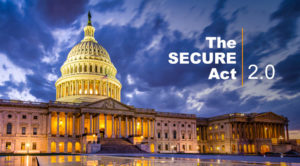Blog
What SECURE Act 2.0 Could Mean For 401(k) Plans- (Pending Legislation)
July 13, 2022
 SECURE Act 2.0 builds on the Setting Every Community Up for Retirement Enhancement Act (Secure Act) of 2019. It is intended to help expand access to workplace retirement plans, encourage saving, and preserve retirement income. To accomplish these goals, the bill currently contains several provisions that would affect plan design, eligibility, contribution processing, and the timing of distributions. Additionally, many of the proposed changes would be mandatory, meaning plan sponsors would be required to adopt them.
SECURE Act 2.0 builds on the Setting Every Community Up for Retirement Enhancement Act (Secure Act) of 2019. It is intended to help expand access to workplace retirement plans, encourage saving, and preserve retirement income. To accomplish these goals, the bill currently contains several provisions that would affect plan design, eligibility, contribution processing, and the timing of distributions. Additionally, many of the proposed changes would be mandatory, meaning plan sponsors would be required to adopt them.
1 -Auto-enrollment and auto-escalation
What’s proposed—Employers setting up new 401(k) plans would be required to automatically enroll eligible employees at a default rate between 3% and 10%; they would also have to automatically increase the rate by 1% annually, up to a specified limit. Employees would still be able to opt out and change their contribution amount.
The purpose—Most people understand the importance of saving for retirement, but inertia often gets in the way. Auto-enrollment and auto-escalation help participants build their savings by putting inertia to work for them. Historically, a small percentage of participants opt out or lower their contribution rate.
2- Roth matching contributions
What’s proposed—Plan sponsors may offer participants the option to designate some or all their employer matching contributions as Roth.
The purpose—Currently, all matching contributions are pretax. This provision would enable participants to choose the designation—pretax or Roth—that best aligns with their current and expected tax situation. It is also intended to be a revenue generator. Designated Roth contributions aren’t excludible from participants’ income.
3- Roth catch-up contributions
What’s proposed—401(k) catch-up contributions (if offered) would have to be designated Roth contributions.
The purpose—This provision appears to be a revenue generator to help offset the cost of other SECURE Act 2.0 proposals. Plan sponsors who offer catch-up contributions but do not currently offer Roth contributions would have to amend their plan documents to add them.
4 -Higher catch-up contribution limits for certain older workers
What’s proposed—Participants aged 62 to 64 would be able to make up to $10,000 in catch-up contributions (indexed for inflation) beginning in 2023 after maxing out their regular 401(k) contributions. As noted above, these contributions would have to be designated as Roth.
The purpose—For 2022, participants who are aged 50 and older can make up to $6,500 in catch-up contributions. This proposed provision would enable workers aged 62 to 64 to save an additional $3,500 in the years leading up to their retirement, helping them retire with increased savings.
5 -Student loan matching contributions
What’s proposed—Plan sponsors would be able to make matching contributions to an eligible employee’s 401(k) account based on the employee’s student loan payments.
The purpose—It is no secret that student loan debt is hindering some workers’ ability to save for retirement, and many plan sponsors have been seeking a way to address this barrier. This provision would allow all plan sponsors to make matching contributions on student loan payments, which was previously approved by the IRS for one employer through a private letter ruling.
6 -Reduced service requirements for long-term, part-time employees
What’s proposed—Long-term, part-time (LTPT) employees would be eligible to contribute to a 401(k) plan after two years.
The purpose—Under the SECURE Act, LTPT employees must complete three years of service to be eligible. The one-year reduction means they would be able to participate sooner and have an extra year to build their retirement savings.
7 -Delayed RMDs
What’s proposed—The age for required minimum distributions (RMDs) would gradually increase from 72 to 75.
The purpose—One of retirees’ greatest fears is running out of money. Raising the age for RMDs would give participants more flexibility when creating their deaccumulation strategy. It would also enable them to keep more of their money invested in their retirement plan or IRA for a longer period, should they so choose.
8- Increased tax credits for small businesses start-up plans
What’s proposed—The credit for retirement plan start-up costs would increase from 50% to 100% for employers with 50 or fewer employees. An additional credit of up to $1,000 per employee would also be available based on the employer contributions made to the plan. This credit would be phased out for employers with 51 to 100 employees.
The purpose—Cost is one of the primary reasons many small business owners do not offer a 401(k) plan. These credits help address this concern and may encourage employers to establish a plan to help their employees save for retirement.
SECURE Act 2.0 has the potential to change the retirement landscape, but its passage this year may come down to timing and other congressional priorities. Congress’s August recess is only three months away, followed by the midterm elections. The bill still needs to pass the Senate, and any differences between the Senate and House versions would have to be resolved before going to the president for signature. There is also a possibility that Congress could tack parts of SECURE Act 2.0 on to other must-pass legislation.